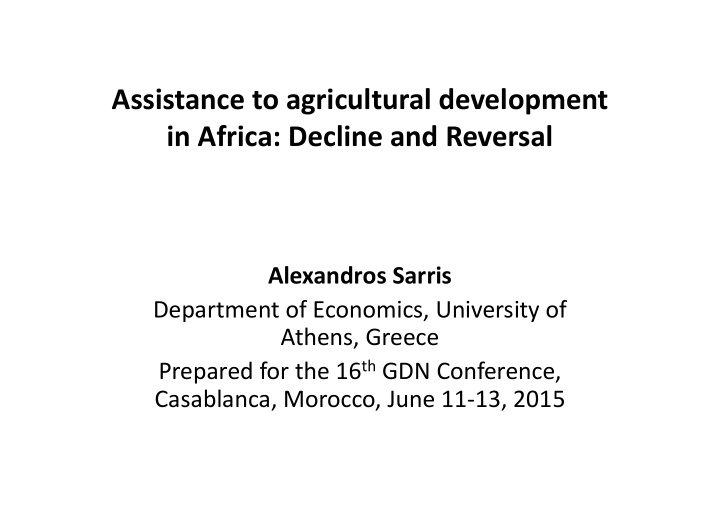



Assistance to agricultural development in Africa: Decline and Reversal Alexandros Sarris Department of Economics, University of Athens, Greece Prepared for the 16 th GDN Conference, Casablanca, Morocco, June 11-13, 2015
Plan of presentation • Agricultural transformation and development • Agricultural transformation in Africa • Finance and agricultural transformation • The productivity and finance gaps • Financial flows from governments to agriculture • Financing needs (“social lending gap”) for smallholder based agriculture development • Traditional models of rural finance • Recent rural financial innovations
Agriculture in transformation and development • Four phases 1) Beginning phase: agricultural labor productivity starts to increase 2) Agricultural surplus: agricultural productivity growth generates surplus towards the development of the non- agricultural sector (Lewis) 3) Integration: agriculture becomes increasingly linked to the rest of the economy through improved infrastructure and market development (Mellor) 4) Industrialized: integration is successful and the role of agriculture diminishes to just one of the many major sectors of the economy Currently most LICs in Africa are in phase 2 (some in phase 1) and LMEs are in phase 2 or 3.
Evolution of agriculture’s share in GDP
Essentials of agricultural transformation Productivity, particularly of labor is the centerpiece of agricultural transformation: The basic cause and effect of the structural transformation is rising productivity of agricultural labor. There are three ways to raise labor productivity in agriculture (and the first two are usually linked): 1) Use new technology to produce more output for a given amount of labor (an agricultural revolution). 2) Let agriculture workers migrate to other occupations, without lowering output, thus sharing the output with fewer rural people (the classic Lewis model of development, leading to an industrial revolution) 3) Through higher prices for agricultural output (make it worth more in real economic terms), which may well be happening in the current economic era, but is a reversal of historical trends. This would be a price revolution based on scarcity rather than surplus). Today this context is complicated by globalization, integrated value chains, rapid technological and institutional innovations, and environmental constraints
Agriculture in Africa • Extensive cultivation patterns. Subsistence farming prevalent. • Excess land, allows shifting cultivation. • Community rights to land and water • Low productivity as technology mostly traditional, scarcity of labor at peak times. • Net result virtually constant level of output and labor productivity
Agricultural productivity gaps world wide
Constraints on rural development in world agriculture • Small size of farms limits productivity growth of labor • Reduction of land size parcels due to inheritance tends to increase tenancy • Weak local or regional markets • Expensive inputs unless subsidized by government • Considerable non-diversified and non-insured risks in production and incomes • Lack of finance for production and consumption
Investment in agriculture in selected low and middle income countries by source
African government agricultural expenditures 2003-9 compared to Maputo declaration target of 10% of total public spending
Donor assistance for agriculture in Sub-Sahara Africa 2002-11
Main recipients of agricultural aid 2007-8
Aid to agriculture by sector 2003-8 (average annual commitment, mil $ constant 2007 prices)
Global distribution of smallholder farmers
Finance and agriculture Financial market imperfections that limit access to finance key to • agricultural and overall development Access to finance not easy to measure. Financial access by • agricultural households is limited in LICs EMEs and barriers to access are common Different financial services required by different groups of farmers. • Risk management and mitigation of paramount importance for poorest. Insurance cannot be separated from credit • Access to finance both pro-growth and pro-poor. Spillover effects of • financial development are likely to be significant Provision of financial services to the poor will require subsidies • For the rural smallholders (about 450 million worldwide) credit not • the only service needed, but also savings and payment systems Mulinational buyers increasingly rely on smallholders for • procurement of supplies. Chief obstacle is large and largely unmet need for formal value chain finance.
Typologies of agricultural value chains
Estimates of the “social lending” (ie combination of market return and social impact) financing gap to agriculture (Source. Dahlberg) About 90% of production involves local staples. Rest is exportable and other cash crops
Social lending models • Replicate and expand existing models (to new crops, new areas) • Innovate into new financial products beyond short-term export trade finance • Finance out-grower schemes of multinational buyers in captive value chains • Finance alternative forms of aggregation (warehousing, procurement networks, input providers, etc.) • Finance direct to farmer. Pertains to staple production, hence largest need. Variation of microfinance models, mobile banking, etc. Expensive model as farmers dispersed.
Existing models of rural finance • Family and friends network “informal” finance • Interlinked credit (credit with labor, or credit with land sharecropping, etc.) • Microfinance through group lending • Input supplier finance (interlinked trade and short term credit) • Trader finance (interlinked trade and short term credit) • Cooperative finance • Government finance via monopolistic purchasing and input supply parastatals
Recent rural financial innovations • Supply chain models (mostly linked to exports) • Combining weather index insurance and rural credit • Cereal banks • Warehouse receipt systems • Mobile banking
Conclusions • Agricultural transformation entails considerable financial needs • Lack of finance can choke off agricultural development and poverty reduction • Government financial flows into agriculture inadequate • Donor flows small compared to needs • Very large investment financing needs for agricultural transformation • Most agricultural transformation and poverty reduction must be based on a smallholder model of development • Large gaps in smallholder financing needs compared to existing flows • Traditional rural financial institutions inadequate to meet needs • Several promising rural financial innovations are emerging
Thank You
Recommend
More recommend